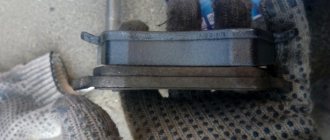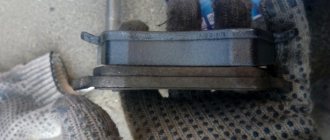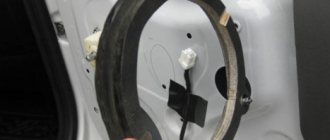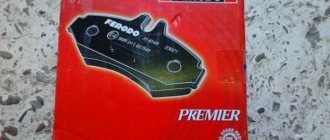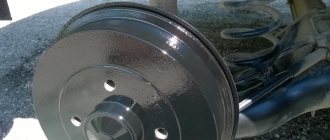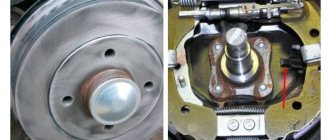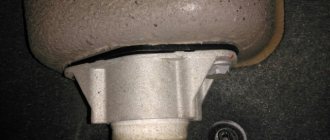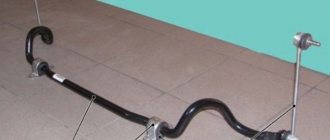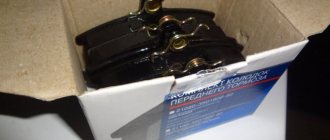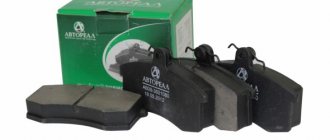Please note that rear mudguards are not installed on Lada Vesta from the factory - these are new trends in the automotive industry. Mud flaps are needed to protect the body from the effects of dust, dirt, and flying stones from under the wheels when driving. The front part of the car suffers the most from these factors. Rear mudguards on the Lada Vesta model will similarly not be superfluous, perhaps even elongated, especially when driving on Russian roads, where you can really find everything your heart desires. The Lada Vesta car manufacturer, following the example of other factories, decided to install only front mudguards on the car. Attentive West owners began to buy and install the missing rear protective accessory, which was not installed by the factory. Many have found better quality replacements for factory parts. Read the article and find out how to install protection against splashes and dirt without compromising the design or practicality of the machine.
Do I need to buy these accessories?
These elements play the role of additional protection of the body from water, stones, dirt, sand and reagents that sprinkle the road. All this flies out from under the wheels, sticks and damages the surface of the car.
On Lada Vesta such shields are installed on the front - they partially protect the bottom of the car. But at the back you have to install them yourself. Experienced motorists consider this a necessary measure, because even good anti-corrosion treatment of vulnerable areas is not always effective, given such a factor as domestic roads.
Rear guards not only protect the body from dirt, but can also prevent stones from flying out from under the wheels onto cars behind.
Installing front mudguards on Vesta is also necessary when the standard ones become unusable. In addition, the car owner may want to install wider models that do their job better.
Bottom line
So, to summarize, we can say that installing rear mudguards on a car is definitely necessary. This step will not only make life easier for other drivers, for whom stones and mud discharge from under your rear wheel will fly into the windshield, but also directly for you. After all, when installing this element, you will protect vulnerable parts of the body, namely the rear wheel arches, from corrosion and contamination. Thus, the service life of the entire vehicle will increase significantly.
Regarding the second question - what type of material to choose, it is certainly worth thinking about. When choosing a rubber option, you will receive a number of significant advantages, but also a significant disadvantage - the car will not be able to sit idle for a long time during cold weather.
Otherwise, it will be fraught with damage to the mudguards, almost instantly. In this case, your Lada Vesta should have a garage that will be able to protect it from the cold. By choosing the plastic option, you will also receive a large number of advantages. Well, the disadvantages with this choice are not significant at all. Dirt and water can be removed manually at least once a day. But regarding the fact that they break when they fall into a hole, you should understand that many other things related to the suspension also break. So, judging by this principle, then wheels are not needed. In general, the plastic option, according to many, is more advantageous.
Selection of mud flaps for Lada Vesta
Front mudguards of Lada Vesta There are options on the market made from two materials:
Each of them has its own performance properties.
Rubber models
Rubber mud flaps are considered traditional for Russian cars. They are inexpensive and have good elasticity, which minimizes damage and does not impair the aerodynamics of Vesta. Cleaning these shields is not difficult.
The disadvantages include their insufficient durability - after 2-3 years there is a need for replacement, because Due to temperature changes, this material begins to burst and crack.
Plastic models
In this case, wear resistance is many times higher. These mudguards are durable and resistant to temperature changes. And plastic products look more impressive.
The downside is that they are prone to damage when hitting a large rock or running over a curb. Plastic is more difficult to clean and aerodynamics may suffer.
I was issued a fine, what should I do now?
If a traffic police officer discovers that your vehicle has a broken or missing mudguard, he will immediately begin the procedure for issuing an administrative resolution. violation. In accordance with the law, you can appeal/challenge this document to the regulatory authority. The traffic police officer only needs to immediately indicate his disagreement with the preventive measure being applied and insist on reducing the punishment from a fine to a warning to eliminate this minor malfunction.
Considering that inspectors themselves don’t particularly like to get involved in drawing up protocols for minor violations, you have a good chance that the traffic police officer will change his mind about issuing you a fine. Using the money you would use to pay off the fine, we recommend purchasing and installing a splash guard, so as not to get on your nerves in the future and not get into conflicts with law enforcement inspectors.
To avoid the cost of paying a fine for the absence of mudguards, it is enough to inspect your car once a week and carry out a technical inspection more often, during which the absence or simply breakdown of this part can easily be revealed. If it is discovered that there is something wrong with it, then it is necessary to replace it immediately, and not put it off, hoping that the inspectors will not notice it. Help! Do not forget that there are many other small reasons due to which traffic police officers can easily charge you a fine. For example, if your windshield wiper or double-glazed window heating device, door locks, or even the seat adjustment mechanism is broken. For all these listed breakdowns, you will have to pay a fine of 500 rubles, that is, the same amount as in the absence of mudguards. Because of this, you need to be attentive to your vehicle.
Price for rear mudguards Lada Vesta
Today, the choice of these elements is quite diverse, both in terms of manufacturer and price segment. Let's look at the existing options:
| Production | Material | Cost (RUB per pair) |
| AvtoVAZ | Polyurethane | 1185 |
| Novline | Polyurethane | 1300 |
| Guard | Rubber | 800 |
| Autodriver | Rubber | 750 |
| Seintex | Rubber | 1200 |
| Norplast | Polyurethane | 1000 |
The kit usually includes right and left shields, instructions and screws.
You can buy rear mudguards for Lada Vesta in one of the online stores. In Moscow, goods are delivered on the day of order. If necessary, you can also purchase options for front mounting.
Article: 7080100131more, additional articles: 09168hide
Order code: 507411
In stock Available for order – 4 pcs. Data updated: 05/28/2021 at 20:30
Order code
507411 Articles 7080100131, 09168 Manufacturer BALAKOVO SPARE PARTS Catalog group: ..Hood, fenders, radiator trim (tail) Body Width, m: 0.21 Height, m: 0.08 Length, m: 0.3 Weight, kg: 0.42
Product reviews
Certificates
Reviews
There are no reviews for this product yet.
Write a review
- LADA Vesta mudguard rear set Article: 7080100131, 09168 Order code: 507411 570 ₽ or place an order by calling 8 800 6006 966
Availability of goods in warehouses and stores, as well as the price of the goods is indicated on
28.05.2021 20:30
.
Prices and availability of goods in all stores and warehouses are updated once an hour.
If there is a sufficient quantity of goods in the store you need, you can buy it without pre-ordering. Internet price
– valid when ordering on the website or through a call center operator by phone
8-800-600-69-66
. Subject to sufficient quantity of goods at the time of order.
Price in stores
– retail price of goods in store sales areas without pre-order.
The period for moving goods from a remote warehouse to the warehouse of an online store.
The parts data presented on this page is for informational purposes only.
4b753a61e2457d58b4a93742e14fcf60
Add to cart
Available to order:
Order quantity:
Product successfully added to cart
!
Installing rear mudguards
Installing mudguards You will need the following tools:
- wheel wrench (for unscrewing wheels);
- jack;
- drill;
- crosshead screwdriver;
- brush (for cleaning attachment points).
Everything is done according to the following instructions:
- Raise the car with a jack and remove the wheel.
- Clean the mounting area from dirt, but be careful not to damage the paint.
- Install the rear mudguard using 2 self-tapping screws using the standard holes.
- Drill additional holes (5 mm) in the places indicated on the diagram (included in the kit).
For installation of some models, standard holes are sufficient. An example of this is the Gard mudguards on the Lada Vesta.
Do you need mud flaps for Lada Vesta?
The absence of this part on the factory version of the car negatively affects the wear resistance of the body and wheel arches of the Lada Vesta.
As practice shows, without rear mudguards, a Russian car becomes vulnerable to dirt, water, and reagents that get into unwanted places and provoke the active spread of corrosion.
At high speeds, the air flow causes a variety of different contaminants to be deposited on an unprotected vehicle. Therefore, having rear mudguards can save you from premature aging of your car.
Installation on Lada Vesta
For Lada Vesta you can find high-quality mudguards costing no more than 1300-1500 rubles.
Installing this element yourself will consist of several steps:
- Remove the rear wheel, clean the surface of the arch from dirt, a stiff brush is usually used for this.
- Using self-tapping screws (it is more convenient to use self-tapping screws with a diameter of 4.2 mm and a length of 16 mm), attach the rear mudguard to the car; usually they are accompanied by a diagram according to which you should proceed.
- Two additional holes with a diameter of 5 mm are made independently. It is better to drill them next to the factory ones at an equal distance, one at the top of the mudguard and one at the bottom, immediately after that treat them with an anti-corrosion agent.
Properly selected and installed rear mudguards on the Lada Vesta will reduce the amount of dirt that flies out from under the wheels onto cars driving behind. By the way, original parts and some other accessories for Lada Vesta are already on sale, which will have a relatively low cost. But you can also use universal versions of products from companies such as Sparco or Elegant, which will have to be modified at the time of attachment to the car.
Causes of washer malfunction
If the windshield washer does not work, it will not be difficult for an experienced driver to identify the cause of such a malfunction, and even a beginner, after familiarizing himself with the main failures in the cleaning system, will be able to eliminate them on his own.
Mechanical problems
The most important reason, as mentioned above, may be the lack of washer fluid; in this case, you just need to top it up. If it is present, but does not splash in the winter, then perhaps it is simply frozen. In this case, the problem can be solved in one of two ways:
- warming up the engine;
- bringing the car into a warm garage.
After the liquid has thawed, the system will begin to operate as usual, but it is better to drain the water from the tank after this and replace it with an “anti-freeze” one.
Other significant mechanical reasons why the windshield washer does not spray include the following factors.
- Clogged injectors. Their exit can be blocked by various debris: rust, dirt or small particles. To check the correctness of the guess, you need to stop the supply of working fluid to the nozzles; if this is the case, then the supply of “anti-freeze” will be normal. The solution to this problem lies in replacing the nozzles.
- Disconnecting the hose. It may simply fly off while driving on bumpy roads, and then the fluid supply will continue, but the headlight and windshield washer nozzle will remain dry. Sometimes this happens in cars in which the connecting fittings are located on the hood, then when it is closed, the hoses are squeezed. In any case, the deformed or torn tube must be replaced and returned to its place.
Electrical faults
After checking the fluid level, the cleanliness of the injectors and the hose leading to them, it may turn out that all this has nothing to do with it, then the issue is for the following reasons:
- Fuse blown. You will need to find the safety block and check the insert; it can be found using the attached diagram, which is usually printed on the cover or in the car’s operating instructions. After checking, if this is indeed the reason, then you need to replace the damaged part
- Motor failure. To establish the accuracy of your guess, you should connect a multimeter to the motor terminals and check the voltage when you turn on the washer. If the voltage indicator is normal, but the motor remains inoperative, then the problem lies with it. You can determine which motor has failed by elimination, by moving the pump terminals from the windshield to its rear counterpart.
- Washer switch malfunction. It is usually located on the steering wheel. If, after checking the voltage, it is missing, and replacing the motor with a new unit did not help, then it turns out that the windshield washer switch or relay is not working. Only an experienced auto electrician can accurately diagnose a breakdown.
- Oxidation of pump terminals. During operation, they can not only oxidize, but also completely fall off, which is why the motor stops pumping liquid. To return everything to working condition, you need to clean the oxidized terminals or replace them with new ones.
Which material is better?
The most popular and in demand material for the manufacture of these parts on the Lada Vesta is rubber. This material can withstand various loads well, it is flexible and elastic, not brittle and brittle. The rubber adapts to any conditions dictated by the track; dirt and water easily drain from them.
Rubber accessories do not affect the aerodynamics of the car, as they adjust and change their position depending on the driving speed. The disadvantage of this material for making mud flaps is that the rubber is prone to aging and wear. On average, rubber products need to be replaced every year and a half, as they wear out and become unusable. Rubber can change its properties depending on the ambient temperature. In severe frost, rubber of this type heats up, and such mud flaps often crack and break.
Rubber models are more resistant to wear
Rubber is an elastic material, bends easily, and does not break when passing obstacles such as storming curbs and/or city road irregularities. Rubber products are easier to clean, do not crack in severe frost, and prevent the accumulation of dirt.
Plastic models “thanks to” some personal “cons” are a little less common. The stationary surface of plastic products contributes to the accumulation of road dirt, increasing the frequency of visits to car wash complexes. At speed, plastic mudguards hold their shape and work effectively at high speeds.
The final choice is made by the owner of the car. The error is corrected effortlessly at a low cost, without leading to consequences.
Enlarged mudguards - watch the video on how to install them. Very helpful.
Are there mudguards on Vesta?
Of course, although rear mudguards are not included in the standard equipment of the Lada Vesta, they can be installed separately, at the request of the owner. But the question is, how much do you need them?
Also, if you decide to install them, you will have a difficult choice ahead of you, among a wide range of markets and stores selling not only high-quality front and rear mudguards, but also Chinese analogues that are of very low quality. Installing this element on a Lada Vesta car will have several positive qualities:
- completing the appearance of the car;
- protection of the body from corrosion;
- protection of vehicles behind from stones and dirt flying from under the wheels.
Undoubtedly, an important positive quality will be the protection of the body from corrosion, since when moving at high speed, the wind deposits a large amount of dirt and reagents on the arch, which quickly destroy the integrity of the metal. Therefore, it would be better to install rear mudguards on the Lada Vesta.
conclusions
Mud flaps must be installed or regularly replaced on any vehicle. This need also affected the Lada Vesta, in which this accessory is made of polyurethane. If possible, it is better to replace them with rubber ones. The presence of such components when equipping a car will extend the service life of the body part and preserve the integrity of the paintwork. At the same time, Lada Vesta owners do not have to worry about wasting their money. They will save significantly more money on car body repairs, since it will be reliably protected from external factors.
Installation
When you choose mud flaps in a store or on the market, remember that the average estimated cost for one set is at least 1300 - 1500 rubles.
More expensive, there is also no point in buying.
Before you begin installing this part, you will need to carry out some preparatory procedures. The first thing you need to do is remove both rear wheels from the Lada Vesta. Next, using a special brush, clean the surface of the arch from all dirt and let it dry completely.
Now that the surface of the arch is cleaned and prepared for installation, it is necessary to mark the places on it where the screws that secure the mud flaps to the body will go. To fasten this part, it is recommended to use screws measuring 4.2 mm in diameter and no more than 15 mm in length.
After the holes are made in the body, treat them with anticorrosive. Next, install the rear mudguards in their places, on the same side as the front ones. Now you can safely fasten them and check how tightly they fit.
What to do if you are given a fine?
If a police officer stops a car at a stationary or mobile checkpoint to check documents, and then discovers that there are no mud flaps, the driver is issued a decision to impose an administrative fine.
The owner of the car may request the drawing up of a protocol, which will entail time costs, so traffic police inspectors try to avoid such a procedure. In this case, it is likely that the driver will receive a verbal warning and an order to eliminate the detected malfunction (despite the absence of such punishment for this violation).
If a traffic police officer draws up a protocol on the detected violation (in addition to a fine), then the driver must read the document and make a comment. In the addition field, you must indicate that at the time of leaving the parking lot, the mudguards were in place (the presence was checked by visual inspection). Such a remark allows you to try to challenge the fine in court.
The car owner must regularly check the technical condition of the car (either independently or in a specialized service) and promptly replace damaged parts.
Traffic police officers can hold the driver accountable for faulty glass cleaning systems (the defect is easily checked by driving the car on a dirty road).
The safety of not only the driver and passengers inside, but also other road users and pedestrians depends on the health of the car.
